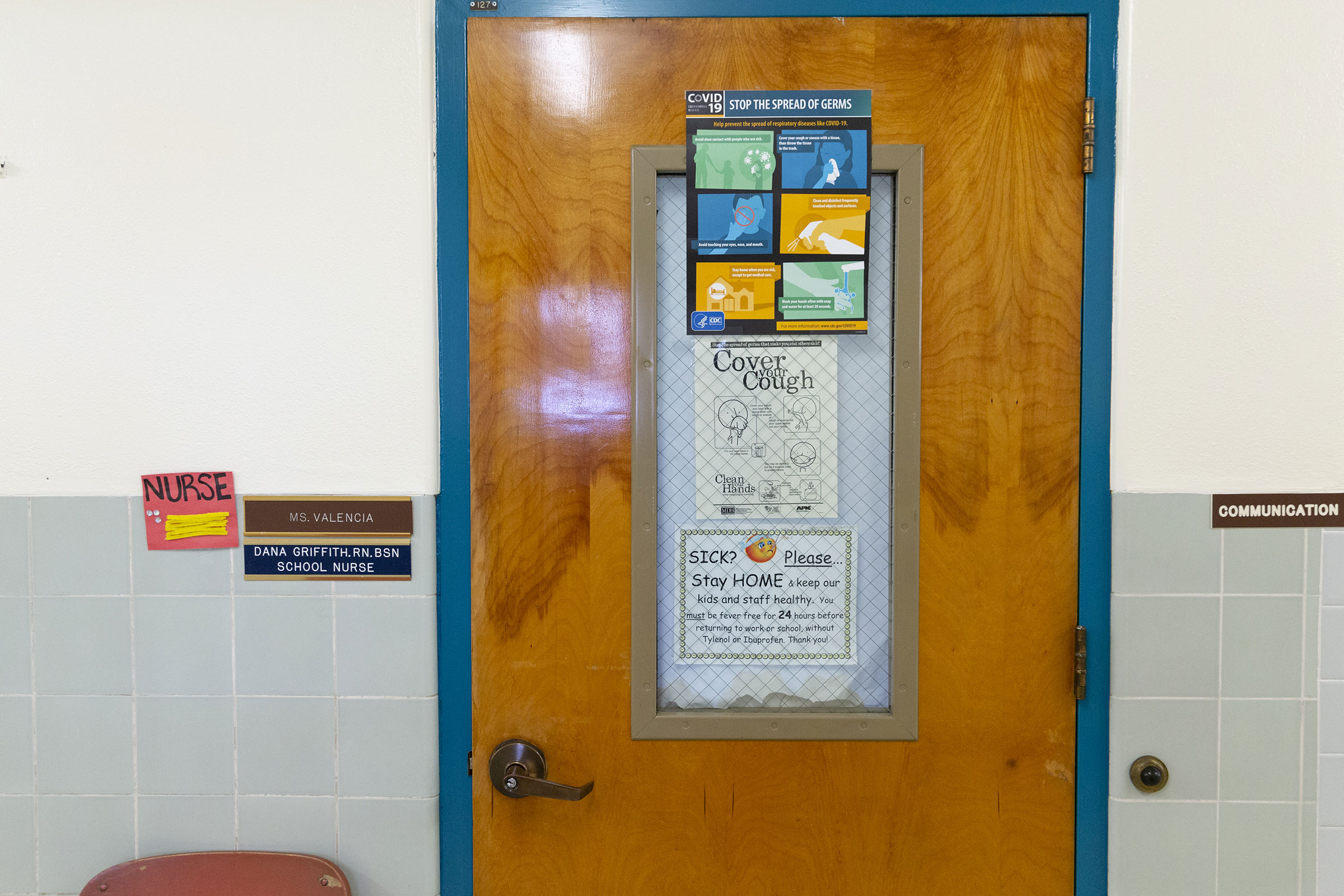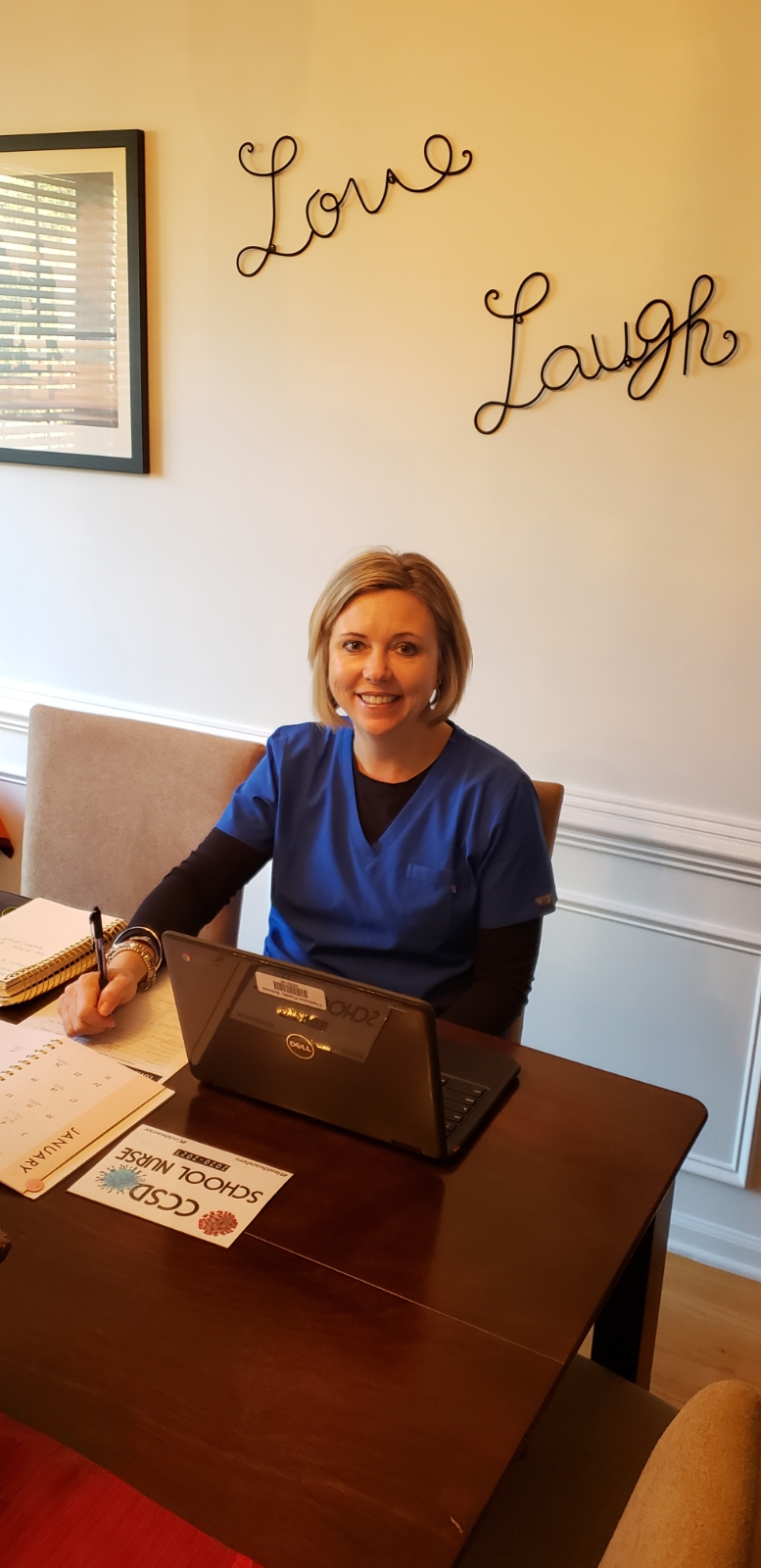
On a Sunday in December, during what should have been her day off, Sherri Groenland was working the phones, trying to track down everyone who had come in contact with the latest COVID-19 case in South Carolina’s Charleston County School District. That meant pulling school bus schedules and classroom seating charts, asking kids to remember who they had been with, for how long and whether they’d been wearing masks.
“Were they in the right seat? And was there distance between them? Was there not?” says Groenland, a nurse at Wando High School in Mt. Pleasant, S.C. “Did they go to after-school care? Do they participate in after-school activities? Who have they been around?”
“It turned into several hours of trying to find people to tell them not to come to school,” she says. The next morning, Groenland made 25 phone calls before 11 a.m. “And that’s not including the stack on my desk right now that I have to call.”
For school nurses like Groenland, the pandemic has upended their routines and expanded their responsibilities, taking them from mending playground injuries and administering medications and throwing them onto the frontlines of the effort to prevent COVID-19’s spread within schools.
This isn't about ice packs and Band-Aids. It's so much more.
“Our whole entire existence revolves around COVID right now,” Groenland says. But if the months since the pandemic began sweeping the country have been a challenge for school nurses, the coming weeks are likely to heap more strain and duties on them as students return from having celebrated the holidays. Many will have traveled and attended family gatherings, despite health experts’ warnings that this could spread the virus, and it will fall on people like Groenland to keep kids and school staff safe in districts where some or all classes are in-person.
“I think that everyone is kind of holding their breath,” says Emily Poland, the school nurse consultant for the Maine Department of Education, who is expecting a flood of calls from schools reporting COVID-19 cases in January. “We have seen this huge surge since Thanksgiving, and schools were out of session for four days.”

The winter holiday break is far longer—close to two full weeks. “So what is January going to look like?” Poland says. “It’s making people nervous. It’s making the school nurses very nervous, wondering how are we going to even manage.”
Getting children back into school safely has been one of the most challenging and polarizing aspects of reopening during the coronavirus pandemic. Many school districts, responding to high levels of community spread, have settled into virtual learning for the long haul. But places where schools are open for in-person instruction have depended on school nurses to monitor virus symptoms, test students and staff for COVID-19, trace the contacts of any positive cases and tell them to quarantine at home.
That’s especially difficult when you’re the only nurse serving hundreds, if not thousands, of students and employees. Just more than half of U.S. public schools had a full-time nurse in 2015-16, the latest year for which such data is available, according to the National Center for Education Statistics. About 18% of schools had no nurse at all. Ahead of this academic year, the National Association of School Nurses called on Congress to pass funding to hire 10,000 more school nurses, calling their role “more important than ever before.”
That’s because the careful balancing act of enabling kids to learn at school, parents to work in person and teachers to be kept safe on the job requires someone to be monitoring symptoms, testing and contact tracing at the center of it all.
In Maine, a team of former school nurses came out of retirement to work on contact tracing coronavirus cases linked to schools. Poland, the state school nurse consultant, has been tasked with manning the hotline for school coronavirus cases and has noticed the surge first-hand. In December alone, she says she received 780 reports of school COVID-19 cases, up from 62 in September.
“This isn’t about ice packs and Band-Aids. It’s so much more,” Poland says, noting that school nurses help kids manage chronic health conditions, educate families and staff on the pandemic and will likely play a role in distributing COVID-19 vaccines when they become more widely available. “They are the only health professionals in a school.”
Read more: Education May Become the Pandemic’s Latest Casualty
In South Dakota — which has had one of the highest rates of COVID-19 deaths per capita, though new cases are now declining — the Rapid City Area Schools district briefly shut all schools and transitioned to remote learning on Nov. 18, when more than 10% of school staff was unable to work because they had tested positive for COVID-19 or were in quarantine, including many nurses. “Almost all of our schools do not have full-time [health] coverage. These are the staff, the only staff in our schools, that are appropriately trained and properly equipped to deal with any symptoms or cases that appear to be COVID-like,” district superintendent Lori Simon said when she announced the closures. “They are absolutely essential.”
The school district in Charleston, S.C., where most students have returned to learning in person five days per week, hired a full-time nurse for every school this year—a ratio of one nurse to every 600 students—and rolled out a COVID-19 testing strategy within schools to identify positive cases more quickly and prevent further transmission.
It was already a lot of responsibility, and I just feel so much more of it these days.
“I’m just responsible for so many people,” says Kathy Nash, a former trauma nurse who now works at Belle Hall Elementary School in the Charleston County district. “Our teachers are already terrified that they’re being sacrificed, and I get that. At the same time, parents have to go to work. I get that. And elementary school kids need to be in school. So it’s, it’s it’s really, really, really tough.”
“It was already a lot of responsibility, and I just feel so much more of it these days,” she says.
That’s true even in districts where all classes are online, but where school nurses must stay in touch with families to ensure students and their relatives are healthy. “We bridge the gap between the medical community and the families,” says Shelah McMillan, a nurse at the Rudolph Blankenburg School in Philadelphia, where school has been fully virtual.
“You just want to make sure they’re all being taken care of appropriately,” she says. “And it is harder to track them because they’re all over the place.” She used Google Voice to set up a phone number to field calls and texts from parents, and she is working to keep track of students who haven’t been logging on to class, checking in to make sure they’re OK.
Read more: Biden Names a Former Teacher to His Cabinet to Oversee Schools ‘In a State of Crisis’
Kim Bartholomew, a school nurse who serves about 2,300 students across three schools with a large low-income population in Oregon’s Beaverton School District, has seen the pandemic’s health crisis converge with unemployment, homelessness and hunger. Her district, which is continuing virtual learning until at least Feb. 8, launched behavioral health and wellness teams in each school in 2020 to help address students’ needs beyond the classroom, knowing that they won’t be able to learn until those other needs are met.
“Calling parents and saying, ‘Your child has not logged on,’ is not effective. What you have to do is figure out the why, and maybe you have to dig deep for that,” she says. Maybe the student isn’t awake yet because they don’t have a bed and have had trouble sleeping. Maybe the parent is unemployed, and the child is feeling anxious. Maybe the family is dealing with homelessness. “Right now, at one of my schools, we’re trying to figure out how to help pay rent,” Bartholomew says. “A family has over $4,000 that they need to pony up for rent.”
Bartholomew, along with school counselors and social workers on the wellness teams, has helped families by writing small grants, delivering boxes of food or putting them in touch with the right community organizations. “I learned years ago that if I serve the children well, it means serving their families,” she says.
We're still seeing kids with injuries, we're still seeing kids with head lice. That hasn't changed. What has changed is I feel like I have a phone attached to myself for most of the day.
During a pandemic that has killed more than 350,000 Americans, that has also meant supporting students through grief. Counselors and social workers in her district have been reaching out to students who lost parents to COVID-19 to give them a space to talk about their feelings. “Sorrow is real, and sorrow needs to be addressed,” she says. “We don’t want children in a deep depression. We want to help them before they get to that point. We don’t want hopeless children.”
Student mental health is one of the reasons why Cindy Begley, a nurse in South Dakota’s Rapid City Area Schools, thinks schools should stay open as long as it can be done safely, even when coronavirus cases rise in the community. She hopes it gives students some degree of normalcy during a year when “nothing seems right.”
Read more: Here’s How Experts Say Joe Biden Could Fix Pandemic Schooling
Now in her 18th year of school nursing, Begley is spending much of her time contact tracing, continuing to call students and families even after she has gone home for the day, trying to find out when they were exposed and telling them when they can come back to school. “We’re still seeing kids with injuries, we’re still seeing kids with head lice. That stuff hasn’t changed,” she says. “What has changed is I feel like I have a phone attached to myself for most of the day.”
When nurses and nursing assistants in her district had to stay home to quarantine, she found herself juggling more work, staying on call to help out other schools if needed. “It’s kind of been a challenging year anyway,” she says. “But when we’ve had lots of cases in our schools, I think the burden has been even greater.”
Groenland, the high school nurse in Charleston, knows there is likely to be a surge in cases after the holidays and is preparing for a busy January of testing symptomatic students and contact tracing around the clock.
“I think we always worry. But, you know, there is some hope now that people are starting to get vaccinated,” she says, noting it will still be a while before vaccines allow schools to return to normal. “But at least there’s a light at the end of the tunnel.”
Correction, Jan. 5
The original version of this story misstated how staff in the Beaverton School District are supporting students through grief. Counselors have reached out to individual students, but the district has not created a formal support group.
More Must-Reads from TIME
- Cybersecurity Experts Are Sounding the Alarm on DOGE
- Meet the 2025 Women of the Year
- The Harsh Truth About Disability Inclusion
- Why Do More Young Adults Have Cancer?
- Colman Domingo Leads With Radical Love
- How to Get Better at Doing Things Alone
- Michelle Zauner Stares Down the Darkness
Write to Katie Reilly at Katie.Reilly@time.com